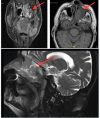A Case of Sinonasal Undifferentiated Carcinoma with Brain Metastases
- PMID: 29755916
- PMCID: PMC5947934
- DOI: 10.7759/cureus.2320
A Case of Sinonasal Undifferentiated Carcinoma with Brain Metastases
Abstract
Sinonasal undifferentiated carcinoma (SNUC) is a rare aggressive neoplasm arising in the nasal cavity and paranasal sinuses. We report a unique case of an 80-year-old man who presented with a locally advanced SNUC involving the ethmoid, sphenoid, and maxillary sinuses and bilateral lymph nodes, clinical T4N2M0. Given his age and the initial extent of his primary tumour, he was treated with neoadjuvant chemotherapy followed by chemoradiation with a split course of 50 Gray (Gy) in 40 fractions delivered twice a day. Four months after his treatments, he developed a recurrence at the left lower eyelid and left frontal sinus, intrabdominal metastases, and a left cerebellar metastasis. A single fraction of 22 Gy was delivered to the cerebellar lesion using stereotactic radiosurgery. He survived 17 months from the initial presentation. We review the available literature regarding treatment of brain metastases and use of hyperfractionated radiotherapy in this rare head and neck cancer.
Keywords: hyperfractionated radiotherapy; induction chemotherapy; palliative radiotherapy; radiosurgery; sinonasal undifferentiated carcinoma; snuc; split course radiotherapy; stereotactic radiosurgery.
Conflict of interest statement
The authors have declared that no competing interests exist.
Figures
References
-
- Reiersen DA, Pahilan ME, Devaiah AK. Otolaryngol Head Neck Surg. Vol. 147. Surgery: 2012. Meta-analysis of treatment outcomes for sinonasal undifferentiated carcinoma; pp. 7–14. - PubMed
-
- Gorelick J, Ross D, Marentette L, Blaivas M. Neurosurgery. Vol. 47. Neurosurgery; 2000. Sinonasal undifferentiated carcinoma: case series and review of the literature; pp. 750–754. - PubMed
-
- Rischin D, Porceddu S, Peters L, et al. Head Neck. Vol. 26. Neck: 2004. Promising results with chemoradiation in patients with sinonasal undifferentiated carcinoma; pp. 435–441. - PubMed
Publication types
LinkOut - more resources
Full Text Sources
Other Literature Sources


